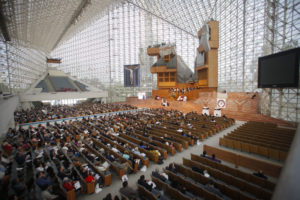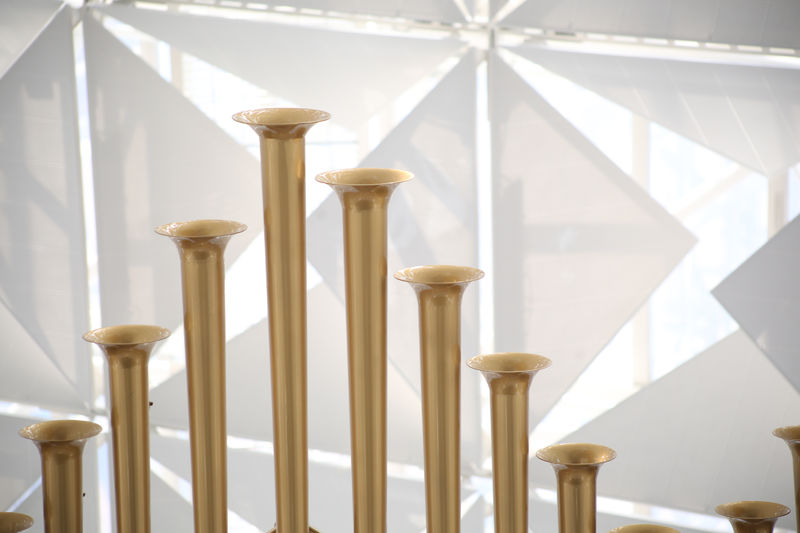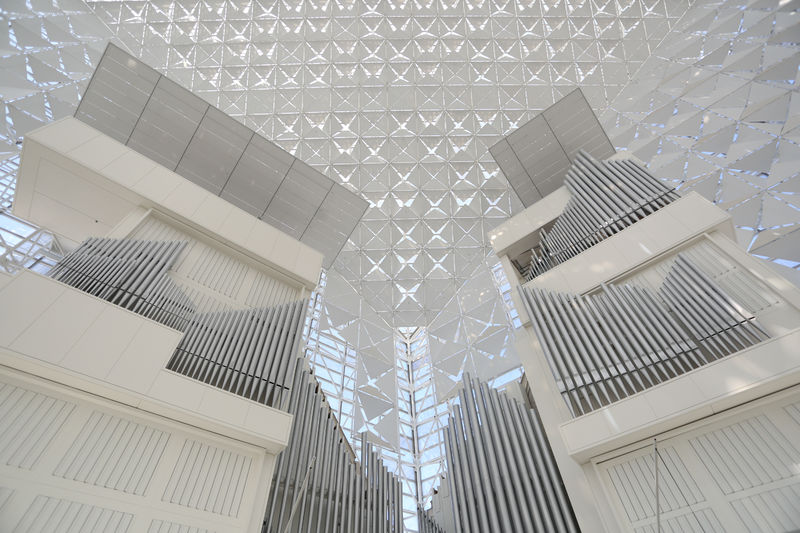The Musical History of Crystal Cathedral: The early years
Music from the service was broadcast to the parking lot so those in their cars could hear. Over the years, music became more important in Rev. Schuller’s services. Arvella Schuller, herself an organist, and the first organist of the church, was the driving force behind the high-quality music program and the acquisition of the new organ.
 According to The Diapason, the official magazine of the American Guild of Organists, Richard Unfried, organist of the Garden Grove Community Church, contacted the firm of Fratelli Ruffatti in 1970 to manufacture a new organ for the Arboretum. The first Fratelli Ruffatti organ, a five-manual instrument of 116 ranks and nearly 7,000 pipes, was installed in the Arboretum in 1977, and inaugurated by famous musician Virgil Fox on April 1, 1977. This was followed by a concert by Richard Unfried, Diane Bish, David Craighead and others.
According to The Diapason, the official magazine of the American Guild of Organists, Richard Unfried, organist of the Garden Grove Community Church, contacted the firm of Fratelli Ruffatti in 1970 to manufacture a new organ for the Arboretum. The first Fratelli Ruffatti organ, a five-manual instrument of 116 ranks and nearly 7,000 pipes, was installed in the Arboretum in 1977, and inaugurated by famous musician Virgil Fox on April 1, 1977. This was followed by a concert by Richard Unfried, Diane Bish, David Craighead and others.
Virgil Fox later made the first “direct-to-disk” recording ever made on a pipe organ, playing the entire program from memory at night, with only a few seconds of silence between pieces. No editing was possible with the technology of the time. Later, the Arboretum’s Fratelli Ruffatti organ was combined with a 1962 Aeolian-Skinner organ to create the Hazel Wright Memorial Organ which was later installed in the Crystal Cathedral.
Hazel Wright Memorial Organ
The magnificent Hazel Wright Memorial Organ, one of the largest in the world, was inaugurated into the Crystal Cathedral in May 1982. The organ was named for Hazel Wright of Chicago who, along with her husband, was a longtime viewer of Reverend Robert Schuller’s television show “Hour of Power” and who donated the funds for its purchase and upkeep. Originally built for the Richard Neutra-designed modernist Arboretum, the organ was combined with another and installed in Schuller’s Crystal Cathedral.
Quick Facts
Hazel Wright Organ is a gift from the late Mrs. Hazel Wright of Chicago. Mrs. Wright also provided an endowment for the maintenance of the instrument.
- This monumental organ is the largest European-built instrument in America, and is the 6th largest organ in the world.
- The original design was by legendary organist Virgil Fox, who died in 1980. Organ Arts of San Francisco, U.S. representatives for Fratelli Ruffatti of Padua, ltaly, handled negotiations with the builders and acted as consultants during installation.
- The organ was inaugurated Friday, May 7, 1982 by French Organist Pierre Cochereau from Notre Dame, American Organist Ted Alan Worth, Full Orchestra, and a Gala Festival Choir of thousands.
- “Hazel” combines the 1962 Aeolian-Skinner instrument from Lincoln Center for the Performing Arts in New York City with the 1977 Ruffatti which was installed in the former Sanctuary of the congregation. A new String Organ and East and West Chamade organs were added by Ruffatti, along with one of the world’s largest drawknob consoles.
- The completed organ consists of 302 stops, 293 ranks (or sets of pipes), and 17,106 pipes. In addition to these impressive resources, 31 Walker Digital ranks were added in 1996 to provide added color and to support congregational singing.
- The organ is comprised of fourteen divisions which can be played individually or in any combination: 1) The Chancel (North) organ contains the Great, Swell, Choir, Positiv, Solo and Pedal divisions. 2) The South Balcony organ consists of the Gallery Great, Celestial, String, Gallery Solo and Gallery Pedal divisions. 3) The Trompeteria divisions, Gospel and Epistle, are in the East and West pinnacles of the building, separated by over 400 feet
- The Chancel (Main) console was built by Fratelli Ruffatti, and is one of the largest drawknob consoles ever built. There are five manuals and a pedal clavier. The resources are controlled by 384 drawknobs, 66 coupler tabs, 115 combination pistons, 55 toe studs, 64 combination memories, 62 miscellaneous controls, four expression pedals and a crescendo pedal capable of four independent settings.
- The South Balcony (Gallery) console was built by M. P. Moller, Inc. and installed in January 1990. The complete resources of the organ can be controlled from this console, though not in a manner identical to the main console. There are 282 drawknobs, 65 coupler tabs, 126 combination pistons, 57 toe studs, 64 combination memories, 47 miscellaneous controls, four expression pedals and a crescendo pedal capable of four independent settings.
 Construction
Construction
The Hazel Wright Memorial Organ was created by Fratelli Ruffatti based on specifications and design ideas from Arvella Schuller, musician Virgil Fox and later, organist Frederick Swann. This instrument was created from two others: the Ruffatti organ built for and installed in the Arboretum in 1977 and the Aeolian-Skinner organ from Avery Fisher Hall of the Lincoln Center in New York City. The Hazel Wright Organ boasts 287 ranks of pipes and over 16,000 individual pipes, all playable from two five-manual consoles. White oak cases hold the nearly 11,000 pipes in the chancel area. There is a rank of forty-four 32-foot pedal pipes, originally in the organ at Bovard Auditorium at the University of Southern California. The South Balcony divisions of the organ contain 5,000 pipes, and in the East and West Balconies are 549 horizontal trumpet pipes—the largest collection of such pipes in the world. The sound, therefore, pours out from all four sides of the Cathedral, for an incredible and unique acoustic experience.
Due to the complexity of the installation, with pipes located at various heights and, in some cases, exposed to direct sunlight, tuning was difficult. Early on, a computerized system was installed by the organ curators, to monitor the temperatures in the various organ locations, thus obtaining vital information for the regular tuning of the pipes. However, after decades of exposure to sunlight, heat, humidity, and in some cases rainwater from leaks in the roof, the organ was in need of urgent repair. Following the acquisition of the cathedral and its 34-acre campus by the Diocese of Orange, Bishop Kevin William Vann, an organist and music lover, launched the project of preserving and restoring the iconic instrument. A farewell fund-raising event was organized: on May 18, 2013, Hector Olivera played the last concert on the instrument prior to restoration, to an audience that nearly filled the building.
Restoration
An “Organ Restoration Committee” led by Monsignor Arthur Holquin, pastor of the Mission Basilica in San Juan Capistrano, has been designated to oversee the restoration of the organ. The restoration process has included the removal of the organ from the Cathedral, transporting the organ to the Fratelli Ruffatti workshop in Padua, Italy, and restoring and reinstalling the organ in the future Christ Cathedral.
In an article penned for “The Diapason” (the official magazine of the American Guild of Organists), Fratelli Ruffatti writes:
The sound of the great Cathedral organ will be returned to its original character. Also, the connections between the Arvella Schuller Carillon and the organ console inside the Cathedral will be repaired, so the 52-bell carillon can once again be played from the organ.

“It’s an enormous job, a gigantic job,” says organist and musician Swann. “But there are extremely worthy craftsmen doing all this. This instrument, tonally speaking, is one of the most exciting I’ve ever played. Playing it is akin to conducting a world-class orchestra.” Swann states that for such a large console, it is surprisingly easy to play and while it takes time to navigate, the logic of the console’s layout becomes readily apparent.
Paul Jacobs, chairman of the organ department at The Juilliard School in New York, who has played famous organs all over the world, says the Hazel Wright Memorial Organ is “a happy marriage between two organ builders. It works as a cohesive whole. This instrument can both whisper and proclaim. And it’s jaw-droppingly impressive to look at. When you hear music come out of those 16,000 pipes it provides a thrill unlike any other.”
Bishop Kevin Vann, Diocese of Orange, who signed the contract in Italy to renovate the organ, is a musician himself. His aunt was a Dominican sister and a music teacher, and his great uncle had perfect pitch and tuned pianos. But when Vann wanted piano lessons, his mother didn’t think he’d stick with it—so his grandparents paid for the first year of lessons. His love of music for the glory of God led to his strong support for the renovation project. He also once hosted a vocal warm-up concert at his residence which was later staged for a sold-out crowd in the Freed Theatre on the Christ Cathedral campus.
In early 2014, the organ was dismantled as part of Christ Cathedral’s renovation and shipped for restoration to Fratelli Ruffatti workshop in Padua, Italy. In early 2016, the Hazel Wright Organ was shipped back to California where it was temporarily stored in an Irvine warehouse before being reinstalled in Christ Cathedral.
Future
The organ was designed to support congregation singing, fill the vast spaces of the Cathedral with sound, and be a resource for musical performances. The Roman Catholic Diocese of Orange acknowledges the cultural importance of the organ, and will continue to honor it, not only for its future in Christ Cathedral through liturgical programming, but also in community arts and cultural programming.